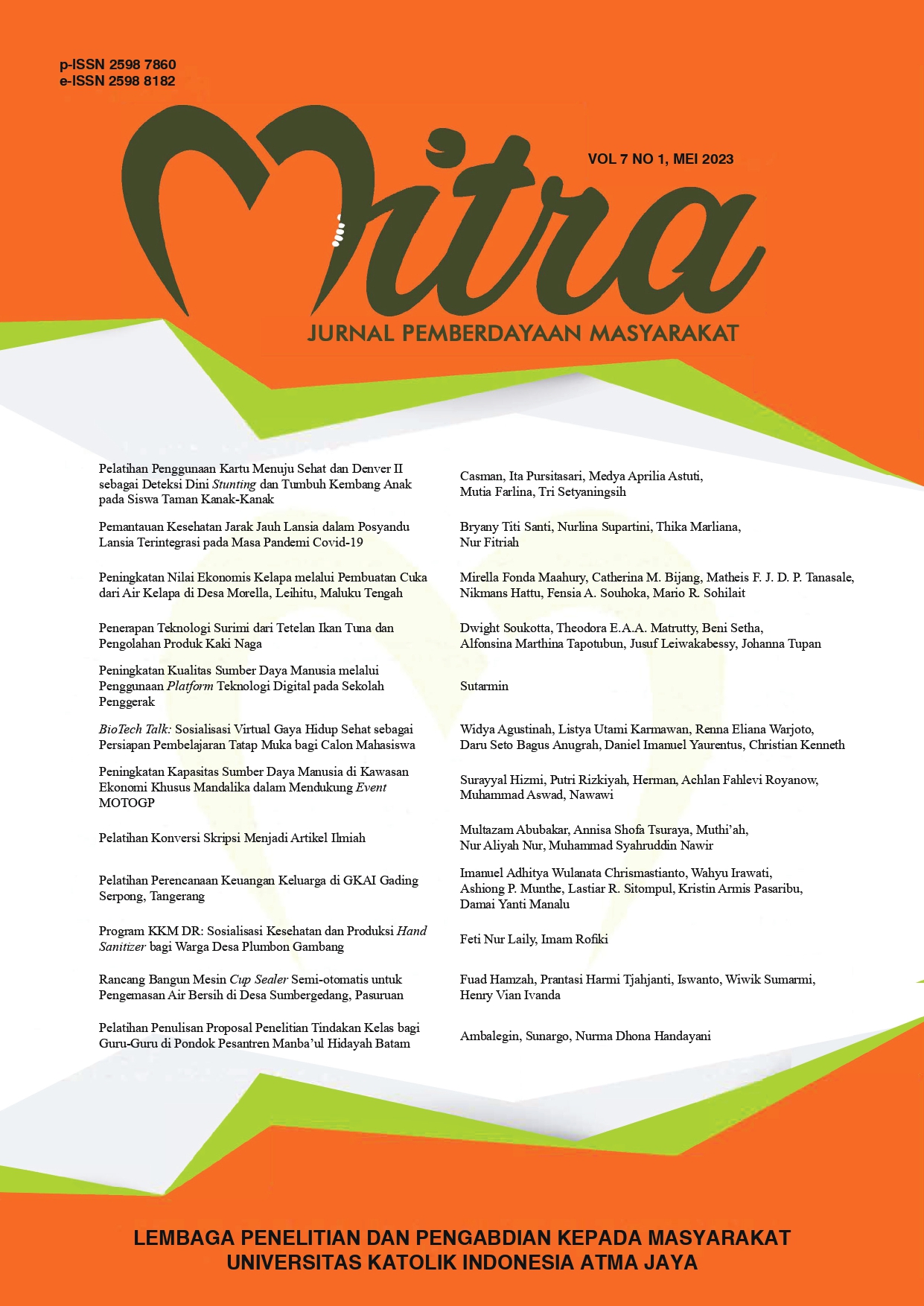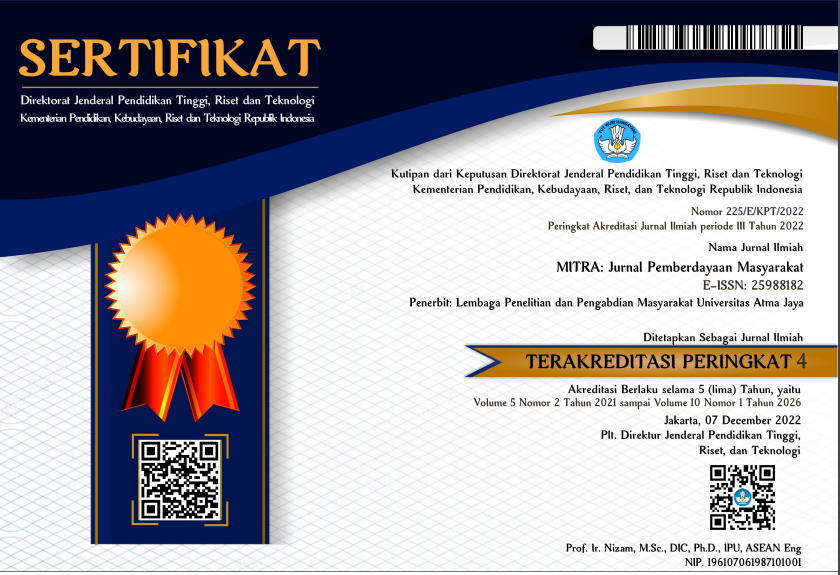Application of Surimi Technology from Tuna Tether and Processing of Dragon Leg Products
DOI:
https://doi.org/10.25170/mitra.v7i1.3328Keywords:
kaki naga, Klasis Pulau Ambon Utara, surimi, tetelan tunaAbstract
The tuna loin industry leaves quite a lot of waste in the form of thin meat tether mixed with fiber. Tuna tethers have good development prospects because they can become the main ingredient for making surimi. Surimi is an intermediate product that has a high functional protein content and has been recognized worldwide. Surimi is the raw material for fish jelly products such as dragon leg, meatballs, nuggets, and others. Based on observations, it turns out that tuna tethers have not been optimally utilized to improve the welfare of the community. The North Ambon Island Klasis area community does not know the processing of surimi and its development opportunities into various competitive products. The purpose of this activity is to utilize tuna tether through the application of surimi technology and dragon foot product processing to household wives from several villages on North Ambon Island. The target audience for this activity was 30 household wives from 17 villages in the North Ambon Island Klasis area. The activities were carried out from March to April 2022, consisting of three (3) stages , preparation, implementation of counseling, and training. The results of the paired sample T test show that there is a significant difference in the knowledge of the target audience before and after the implementation of counseling and training on the application of surimi technology and processing surimi into dragon foot products. The average post-test score of 30 participants increased by 59.39% after participating in counseling and training activities on the application of surimi technology and processing surimi into dragon foot products. At the end of the activity, the participants practiced surimi and dragon foot processing trials, showing 90% of the participants were quite skilled in processing the two products.
References
Gazpersz, F. (2014). Surimi limbah tuna loin sebagai bahan fortifikasi dalam pembuatan bagea sagu.” Majalah Biam, 10(2), 83–89.
Hadinoto, S., & Idrus, S. (2018). Proporsi dan kadar proksimat bagian tubuh ikan tuna ekor kuning (Thunnus Albacares) dari Perairan Maluku”. Majalah Biam, 14(02), 51–57.
Lalopua, V. M. N., & Onsu, A. (2021). Karakteristik kimia dan organoleptik kamaboko surimi tetelan ikan tuna. AGRITEKNO: Jurnal Teknologi Pertanian, 10(2), 74–82. https://doi.org/10.30598/jagritekno.2021.10.2.74
Nanlohy, H., Apituley, Y. M. T. N., Tapotubun, A. M., Reiuwpassa, F., & Matrutty, T. E. A. A. (2017). Management and feasibility analysis of smoked fish business in Ambon”. IOP Conference Series: Earth and Environmental Science, 89(1). https://doi.org/10.1088/1755-1315/89/1/012026
Nugroho, A., Swastawati, F., & Anggo, A. D. (2014). The effect of flour and frying time to the quality of spanish mackerel (Scomberomorus sp.) fish drum stick”. In Jurnal Pengolahan dan Bioteknologi Hasil Perikanan, 3. http://www.ejournal-s1.undip.ac.id/index.php/jpbhp
Rieuwpassa, F., & Tapotubun, A. M. (2017). Memuliakan laut: Pencitraan produk ikan olahan tradisional sebagai identitas daerah Maluku (1st ed.). Pattimura University Press.
Rieuwpassa, F., & Tapotubun, A. M. (2020). Teknologi pengolahan ikan tanpa limbah: Strategi peningkatan pendapatan masyarakat nelayan dan menjamin M-LIN berkelanjutan”. In F. Latumahina & J. P. Haumahu (Eds.), Kapita selekta: Pengelolaan sumber daya kemaritiman dan kelautan Seri I (I, pp. 19–38). Pattimura University Press. www.unpatti.ac.id
Rieuwpassa, F., Tapotubun, A. M., Matrutty, T. E. A. A., & Sormin, R. B. D. (2015). Opportunities of seafood processing development in Southeast Maluku District. International Journal of Current Research, 7(08), 19336–19339.
Siregar, S. (2018). Metode penelitian kuantitatif dilengkapi perbandingan perhitungan manual & SPSS. In Kencana, 8(1).
Tapotubun, A. M. (2021a). Pengolahan ikan dan promosi Maluku sebagai center of fish product. In F. Latumahina (Ed.), Maluku masa depan: Bunga rampai pemikiran para akademisi bidang sains dan teknologi Maluku (I, pp. 1–24). Adab. https://books.google.co.id/books?id=33IqEAAAQBAJ&printsec=frontcover&dq=inauthor:%22Agustina+W.
Tapotubun, A. M. (2021b). Pengolahan ikan sebagai hilirisasi lumbung ikan nasional untuk Maluku Sejahtera”. In V. J. Pical & A. M. Tapotubun (Eds.), Maluku sebagai Lumbung Ikan Nasional,1, 112–130. Balai Pustaka. http://www.balaipustaka.co.id
Tapotubun, A. M., Matrutty, T. E. A. A., Mailoa, M. N., Fransina, I. G., Tapotubun, E. J., & Riry, W. A. (2021). The application of processing technology for jelly candy made with lat sea grapes in southeast Maluku Regency”. MITRA: Jurnal Pemberdayaan Masyarakat, 5(2), 142–148. https://doi.org/10.25170/mitra.v5i2.2597
Downloads
Published
Issue
Section
License
Copyright (c) 2023 Dwight Soukotta, Theodora EAA Matrutty, Beni Setha, Alfonsina Marthina Tapotubun, Jusuf Leiwakabessy, Johanna Tupan

This work is licensed under a Creative Commons Attribution-NonCommercial-ShareAlike 4.0 International License.
This license allows reusers to distribute, remix, adapt, and build upon the material in any medium or format for noncommercial purposes only, and only so long as attribution is given to the creator. If you remix, adapt, or build upon the material, you must license the modified material under identical terms.



_.jpeg)

.png)
2.png)
.png)
.png)



